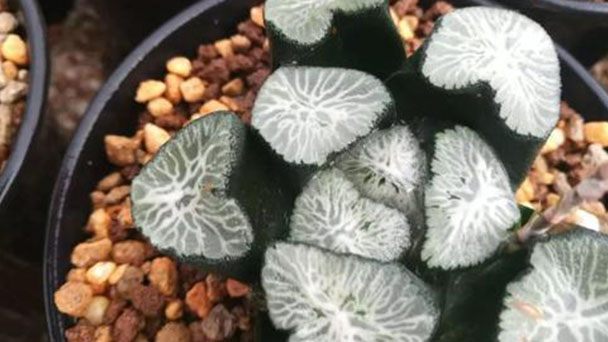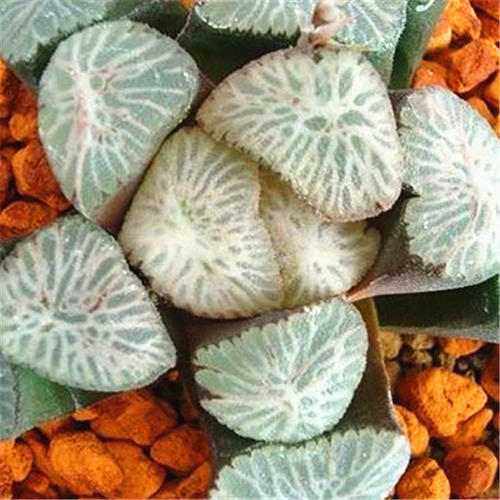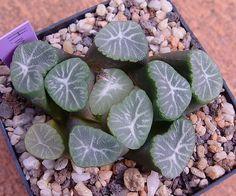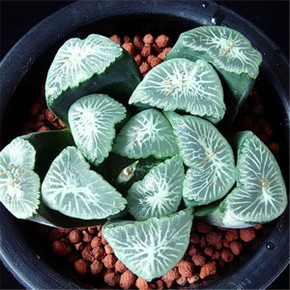Haworthia Maughanii Profile
Written by Maggie
Oct 14 2021

Haworthia Maughanii prefers warm, dry and sunny environments. Haworthia Maughanii leaves are oblique from the base, arranged in loose rosette, leaf semi-cylindrical, truncated at the top, translucent. According to the difference of varieties, there are different patterns, dark green leaves, grey-green or reddish brown, rough surface.
The name Haworthia Maughanii in the watery weed is derived from the kanji of the Japanese kanji, originally named after the Japanese Koshio Shiraishi.
Haworthia Maughanii Picture

Haworthia Maughanii Characteristics
Haworthia maughanii fleshy leaves are oblique from the base and arranged in a loose rosette, semi-cylindrical leaves truncated at the tip, translucent, with different patterns depending on the species, dark green, grayish-green or reddish-brown leaves, rough surface.
Haworthia maughanii is native to Cape Province, South Africa and is also known as the elephantfoot grass, Haworthia maughanii. Very fleshy leaves arranged in a loose rosette. Leaves are obliquely ascending from the base, semicircular, 2.5 cm long (longer in cultivation), 1.5 cm wide at the base. The leaf end is truncated, grayish-green or reddish-brown, the leaf surface is rough, the leaf end truncated surface has the transparent "small window". Inflorescences of haworthia maughanii are 20 cm long, with florets 8 -- 10, 1.2 -- 1.3 cm long, white with green midveins.
Haworthia Maughanii Native Habits
Haworthia Maughanii likes a warm, dry and sunny environment, not cold, afraid of high temperature and strong light, and tolerant to semi-shade. It is better to loose, well-drained sandy loam soil. The temperature in winter is not lower than 10℃.
Haworthia maughanii prefers warm and dry environments, is resistant to drought and is afraid of waterlogging, and is suitable for growing in semi-shade or insufficient and soft sunlight. Avoid sun exposure, or you will make unsightly burn is formed on the leaf spot, leaf color dim lackluster, tip dry, moderate growth, and too much shade can make plant strains caused by loose, blade arrangement is not close, the window at the top of the soft system varieties hairy, transparency reduced, warts on the hard series varieties hairy, not significant, these are not conducive to watch. Winter should be given more light, otherwise, the leaves easily red.
Haworthia Maughanii Care
Transplanting
Use perforated paper towels that will rot in a year or two to stop the holes in the bottom of the bowl. By the time the paper towels have rotted, the 12-roll root system will have a strong grip on the soil. Place the Haworthia Maughanii in the center of the pot and add soil around the roots. First wrap the soil loosely around the roots, then gently tap the edges of the pot to firm the soil. This is best for twelve rolls. It is customary for the author to leave 1/2~1/4 of the bowl for watering, to avoid watering over the basin.
The next step is soil modification, which is not necessary. The surface of the soil can be covered with small stones or gravel, which will give the soil a nice appearance. Apart from the aesthetic benefits of gravel, the practical benefit of gravel is that it insulates wet soil and prevents plant matter from decaying. It also hinders the colonization of fungal spores and prevents pests from laying eggs in moist soil, because the growth of fungi and pests will seriously harm plant growth. The downside of grit is that we don't know what the soil moisture is because of the grit, so we can solve this problem by knowing the weight of the soil when it's dry and when it's wet.
Water
Remember one rule: water when dry, but not when dry. When you water Haworthia Maughanii, water until the holes in the basin started to leak. Do not water again until the soil is dry. Determinate what soil is dry and wet can pass basin weight, best method is to insert soil with a finger or pencil more than 1 foot, see next whether damp.
This method is very effective because once you have a continuous rainy day after watering twelve rolls, you need to cut off the water for four to six weeks. In the summer, however, when the sun is good, Haworthia Maughanii needs to be watered twice a week. The only thing to note is that in cold, wet winters, these plants often rot and die, but if Haworthia Maughanii is kept dry for months, Haworthia Maughanii may eventually revive.
Fertilizer
There is no need to fertilize Haworthia Maughanii if they are to be transplanted frequently (a good idea). Although your Haworthia Maughaniimay grows slowly, there is no danger. Fertilizing is a good idea to make them thrive. But a rule to follow is that fertilization must be done with thin fertilizer, and it must be done during the growing season of the twelfth roll, such as spring and fall. I often use a 1/4 concentration 20-20-20 (nitrogen-phosphor-potassium) fertilizer. The instructions say to dissolve a teaspoon of fertilizer in a gallon of water, but I use only a quarter teaspoon per gallon. Supplying too much food to Haworthia Maughanii can speed up its growth, cause it to become deformed or even burn. Fertilizer carefully, to do rather than excessive.
The demand for fertilizer is not large, generally, a monthly application of thin fertilizer water can be met, concentrated fertilizer and fertilizer should be prohibited, otherwise it is easy to produce fertilizer damage and cause losses, serious whole plant necrosis. Because the Haworthia Maughanii growth is relatively slow, so generally 2 years to change the pot once, in each change the pot to add some ripe organic fertilizer, can ensure the nutritional needs of the plant. Particle fertilizer generally only uses slow-release fertilizer and controlled-release fertilizer.

Haworthia Maughanii Propagation
Haworthia maughanii is mainly propagated by division and cuttings.
Division
When changing the pot in spring, the dense mother plant is removed, and the daughter Haworthia Maughanii is taken out, which can be directly put into the pot. If the root is not much, it can be temporarily inserted in the sand basin, and then potted after taking root.
Cuttings
Cut mature fleshy Haworthia Maughanii leaves, but the base must be attached at the base. Inserted in sand beds. Rooting can take about 20-25 days. Care should be taken during operation to avoid damage to the leaves, otherwise the survival rate will be affected.
Haworthia Maughanii Disease & Pest Care
Disease
Haworthia maughanii main diseases have root rot and leaf spot, in general, root rot was due to improper watering, fertilizing, can through the reasonable management to prevent, in addition, should clear in time when the root rot roots rotted, disinfected, and 500 times liquid of potassium permanganate solution 2-3 days, then dry in the shade again. Brown spot disease needs to be treated with Daxen zinc, carbendazim and other drugs.Spray with 50% carbendazim WP 1500 times liquid.
Insect pests
The main pests of Haworthia Maughanii are mealworms and scale insects, etc. The mealworms are controlled by imidacloprid and insectid aphid. Scale insects can also be prevented by wiping or brushing.Can be used 10% oxidized diethoate emulsion 1000 times the spray.
Haworthia Maughanii Distribution
Most of the Haworthia maughanii succulents are native to South Africa and have been introduced as ornamental plants in countries around the world.
Haworthia Maughanii Benefits
The Haworthia Maughanii plant is peculiar in shape, with blades resembling a file or the tail of a young pheasant. Haworthia Maughanii is very peculiar and interesting. Haworthia Maughanii is very easy to grow and grow normally in the room with sufficient scattered light. Haworthia Maughanii is one of the small succulent plants widely planted by the vast number of garden lovers. To decorate several tables, it is very beautiful and clever.
Haworthia maughanii is a fleshy perennial herb in the genus Liliaceae. Haworthia Maughanii is native to South Africa and has not been introduced into China for a long time. Its plant is exquisite and lovely, the leaf is elegant and comely, often makes the small view leaf plant cultivation. With its bonsai production, the simple "view leaves" instead of "enjoy the scenery", increased the affinity between man and nature, its style is strong and rugged, quite African desert amorous feelings.

Latest Updated
- Benefits of Bugleweed - 7 Science-backed Health Benefits
- Bugleweed Dangers & Side Effects - Is It Poisonous?
- How to Plant Evergreen Trees - What You Should Know
- When to Plant Evergreens - Grow Guide for Evergreen Trees
- 12 Wonderful Evergreen Shrubs for Your Garden
- 12 Popular Evergreen Plants with Pictures for Beginners
- When And How To Prune A Lilac Bush Like a Pro
- How to Grow & Care for Lilac Vine (Hardenbergia Violacea)
- Japanese Lilac Tree (Syringa Reticulata) Care & Propagation Guide
- Shumard Oak Pros and Cons - What to Know
Popular Articles
- Winter maintenance of Antirrhinum Majus
- How to Grow Terminalia Mantaly Tree
- How to Grow and Care for Crossostephium Chinense
- How to grow Antirrhinum Majus in spring
- Peristeria Elata (Dove Orchid) Profile: Info & Care Guide
- Underwatered Snake Plant (Sansevieria Trifasciata) - Signs And How To Fix
- How to Care for Brazilian Jasmine Plant (Mandevilla Sanderi)
- How to Grow & Care for Graptopetalum Purple Delight in Summer
- Rosa Chinensis (China Rose): Plant Growing & Care Tips
- How to Care for Baby Sun Rose (Aptenia Cordifolia)